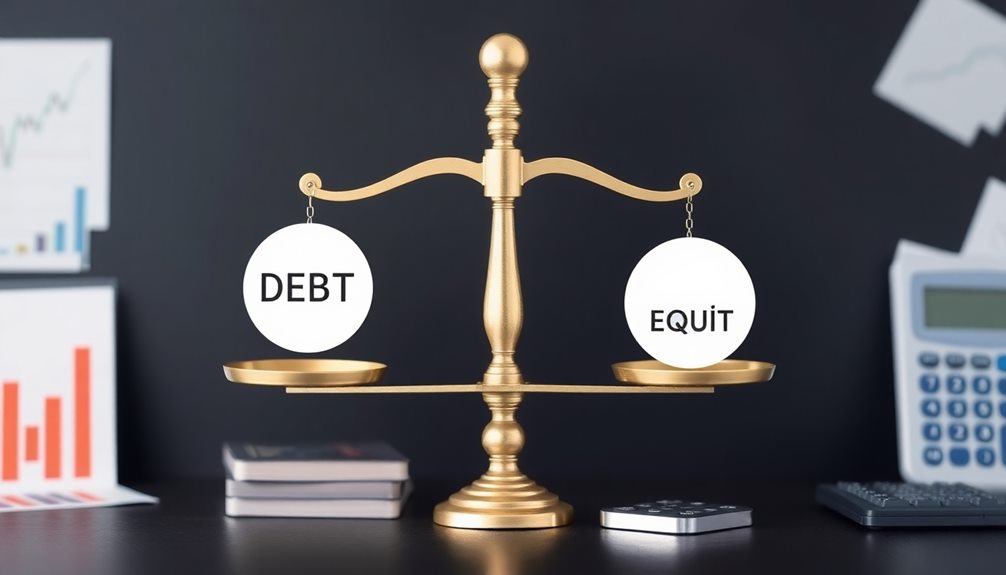The debt-to-equity (D/E) ratio measures your company's financial leverage by comparing total liabilities to shareholders' equity. A D/E ratio under 1.0 indicates more equity financing, which is generally safer, while a ratio between 1.0 and 1.5 is seen as stable. Ratios above 2.0 could raise red flags for investors, signaling higher financial risk. However, what's considered a good value can vary by industry. For instance, capital-intensive sectors might average higher ratios. Understanding your company's D/E ratio and trends can provide valuable insights into its financial health and risk. There's more to uncover about this essential metric.
Key Takeaways
- The Debt-to-Equity (D/E) ratio measures financial leverage, calculated by dividing total liabilities by shareholders' equity.
- A D/E ratio below 1.0 indicates more equity than debt, suggesting safer financial practices.
- Ratios between 1.0 and 1.5 are often seen as stable, indicating a balanced approach to financing.
- A D/E ratio above 2.0 may signal financial distress, implying higher risk for investors.
- Industry averages vary significantly, so it's essential to compare a company's D/E ratio against its sector for context.
Understanding the Debt-to-Equity Ratio

When you're analyzing a company's financial health, one key metric to evaluate is the Debt-to-Equity (D/E) ratio. This ratio is calculated by dividing total liabilities by shareholder equity, serving as an essential measure of financial leverage and risk.
A D/E ratio below 1.0 typically indicates that a company leans more on equity financing than debt, which is generally seen as safe. Conversely, ratios above 2.0 often raise red flags for investors, signaling potential financial distress.
Understanding the D/E ratio involves considering the company's capital structure within its industry context. For example, sectors like banking and utilities might have higher D/E ratios due to their capital-intensive operations, while technology firms usually maintain lower ratios.
If a company has a D/E ratio of 0.4, it means it owes 40 cents to creditors for every dollar of equity, reflecting moderate financial leverage.
It's essential to interpret a company's D/E ratio against industry benchmarks and the broader economic context, as acceptable values can differ notably across sectors. Keeping these factors in mind will help you make informed decisions about the company's financial standing.
How to Calculate the D/E Ratio

Calculating the Debt-to-Equity (D/E) ratio is straightforward and essential for evaluating a company's financial leverage. You can determine the D/E ratio using the formula:
D/E Ratio = Total Liabilities / Shareholders' Equity.
To find shareholders' equity, subtract total liabilities from total assets, as equity represents the owners' claim after all debts are settled. Make sure to use the most recent balance sheet data for accurate calculations, since the D/E ratio can fluctuate based on changes in assets and liabilities.
Here's a quick example to illustrate:
| Total Liabilities | Shareholders' Equity | D/E Ratio |
|---|---|---|
| $300,000 | $600,000 | 0.5 |
| $400,000 | $400,000 | 1.0 |
| $500,000 | $250,000 | 2.0 |
| $200,000 | $800,000 | 0.25 |
In this case, a D/E ratio of 0.5 indicates a moderate reliance on debt. By understanding how to calculate this ratio, you can gain insights into a company's financial health and stability.
Interpreting Debt-to-Equity Values

Understanding Debt-to-Equity (D/E) values is essential for evaluating a company's financial leverage and risk profile. The Debt-to-Equity ratio, calculated by dividing total liabilities by shareholder equity, reveals how much debt a company uses to finance its operations. A D/E ratio of 1.0 is generally deemed safe, indicating equal amounts of debt and equity.
Ratios above 2.0 may signal higher financial risk, while a low ratio can suggest underutilization of debt financing, potentially limiting growth opportunities.
In capital-intensive operations, like utilities and telecommunications, companies often sustain higher D/E ratios without facing distress. Consequently, a high ratio in these sectors mightn't be alarming.
However, a negative D/E ratio reveals financial instability, as it means liabilities exceed assets.
To make informed decisions, you should compare a company's D/E ratio against industry averages. A high ratio may be acceptable in one industry but risky in another.
Industry Variability in D/E Ratios

Industry variability in Debt-to-Equity (D/E) ratios plays a crucial role in financial analysis, as different sectors have distinct characteristics influencing their capital structures.
For instance, capital-intensive sectors like utilities tend to exhibit higher ratios, typically averaging between 1.5 to 2.5. This reflects their significant investment in infrastructure and reliance on debt financing.
In contrast, technology companies usually maintain lower D/E ratios, often below 1.0, due to their focus on equity financing and lower capital requirements.
The financial services industry operates with higher D/E ratios, commonly exceeding 2.0, leveraging debt to enhance returns on equity while managing risk through regulatory frameworks.
Meanwhile, consumer staples and healthcare sectors present moderate D/E ratios, often ranging from 0.5 to 1.5, reflecting their stable cash flows and lower capital intensity.
Real estate investment trusts (REITs) typically have higher D/E ratios, often around 2.0 or more, as they depend on debt for property acquisitions and financing.
Understanding these industry-specific D/E ratios helps you assess a company's financial health and make informed investment decisions.
Implications of High and Low Ratios

High and low Debt-to-Equity (D/E) ratios carry significant implications for a company's financial health and investment attractiveness. A high D/E ratio, typically above 2.0, suggests a heavier reliance on debt financing. This can elevate financial risk, especially during economic downturns, while a low D/E ratio, generally below 1.0, indicates lower financial risk but could show missed growth opportunities.
Consider these implications:
- High Ratio: Signals potential financial instability and increased costs of debt servicing.
- Low Ratio: Enhances investor confidence and indicates financial stability.
- Capital-Intensive Industries: Companies in sectors like utilities may naturally have higher ratios.
- Underutilization of Leverage: A D/E ratio close to zero may mean missed opportunities for growth.
- Negative D/E Ratios: Indicates liabilities exceed assets, often foreshadowing bankruptcy.
Debt Capital's Role in Growth

Debt capital plays a pivotal role in driving a company's growth strategy, particularly in sectors where expansion requires significant funding. By leveraging debt capital, you can access larger amounts of financing for your projects without diluting ownership through equity financing.
This strategic use of debt can accelerate your company's growth by funding new initiatives or acquisitions that may not be feasible with equity alone.
One of the key advantages of debt is the potential for tax benefits. Since interest payments on debt are often tax-deductible, you can reduce your overall cost of capital, enhancing your financial position.
If your company enjoys stable cash flows, managing a higher level of debt becomes more feasible, allowing you to amplify returns on investments as long as those returns exceed the cost of the debt.
Many successful growth-stage companies maintain high debt-to-equity ratios, demonstrating that well-managed borrowing can be a powerful catalyst for expansion.
As you navigate your growth strategy, consider how the strategic use of debt capital can position your company for success while maximizing your financial leverage effectively.
Assessing Financial Health Through D/E Ratio

When evaluating a company's financial health, the Debt-to-Equity (D/E) ratio serves as an essential indicator of its leverage and risk profile. You calculate this ratio by dividing total liabilities by shareholders' equity, giving you insight into how much debt the company uses compared to its equity.
A D/E ratio below 1 is generally regarded as safe, while anything above 2 may point to increased financial risk.
Here are key aspects to reflect on when analyzing a company's D/E ratio:
- Comparison with industry averages: Understand how the ratio stacks up against competitors.
- Trends over time: Monitor changes in capital structure to identify potential red flags.
- Negative D/E ratio: Be wary if liabilities exceed equity, indicating financial instability.
- Impact on financial health: Higher ratios may suggest higher financial leverage and risk.
- Sector-specific norms: Recognize that some industries naturally have higher D/E ratios due to capital needs.
Frequently Asked Questions
What Is a Healthy Debt-To-Equity Ratio?
A healthy debt-to-equity ratio typically ranges from 1.0 to 2.0. This balance shows you're leveraging debt effectively while maintaining financial stability. Keep in mind, acceptable ratios vary across different industries, so context matters.
Is 0.5 a Good Debt-To-Equity Ratio?
Yes, a 0.5 debt-to-equity ratio's considered good. It shows you're using debt conservatively, maintaining financial stability, and reducing risk, making your business attractive to investors while allowing room for future growth and expansion.
Is a Debt-To-Equity Ratio Below 1 Good?
A debt-to-equity ratio below 1 is generally good. It shows you've got more equity than debt, indicating lower financial risk. This can attract investors, but remember, it might limit growth opportunities through debt financing.
What Does a Debt-To-Equity Ratio of 1.75 Mean?
A debt-to-equity ratio of 1.75 means you're seeing a company that relies heavily on debt for financing. This can imply higher financial risk, especially if cash flow isn't stable. Evaluate carefully before investing.
Conclusion
In today's fast-paced financial landscape, understanding your debt-to-equity ratio is essential. It's not just a number; it's a reflection of your company's financial health and growth potential. A balanced D/E ratio can propel you forward, while an imbalance can leave you gasping for air like a fish out of water. By keeping an eye on this important metric, you're setting yourself up for sustainable success in an ever-changing world. So, stay informed and thrive!










